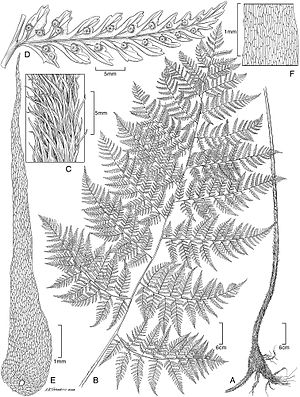Dryopteris sweetiorum
| Dryopteris sweetiorum | ||||||||||||
|---|---|---|---|---|---|---|---|---|---|---|---|---|

Illustration of Dryopteris sweetiorum |
||||||||||||
| Systematics | ||||||||||||
|
||||||||||||
| Scientific name | ||||||||||||
| Dryopteris sweetiorum | ||||||||||||
| Lorence & WLWagner |
Dryopteris sweetiorum is a plant from the genus of dryopteris ( Dryopteris ) within the family of dryopteridaceae (Dryopteridaceae). She is endemic to the southern Pacific Ocean nearby Marquesas ago Islands.
description
Dryopteris sweetiorum grows as a fern . It forms a short, creeping to semi-upright rhizome , which is densely covered with scales and, together with the base of the fronds, is between 3 and 15 centimeters thick. The uniformly glossy dark brown scales on the rhizome and on the base of the fern fronds are oval-lanceolate to linear-oblong with a length of 0.9 to 2.5 centimeters and a width of 0.1 to 0.2 centimeters. They have entire margins or irregularly serrated margins at the base of the scales.
On each rhizome there are five to seven fronds arranged densely in clusters. The fronds have 45 to 100 centimeters long and 0.7 to 1 centimeter thick stems, which are straw-colored to brown. They are furrowed on top and densely covered with brown scales at the base. The size of the scales decreases towards the tip of the frond and hair-like scales also appear.
The double to triple pinnate or pinnately split fronds are 42 to 93 centimeters long and 38 to 80 centimeters wide and are triangular-ovoid in shape and consist of 8 to 13 pairs of leaflets. Most of the time the lower half of the fronds is triple-pinnate while the upper half is usually double-pinnate. The straw-colored main axis of the fronds is sparsely covered with brown scales, which can be 0.2 to 1.2 inches long and 0.2 to 0.6 millimeters wide. The paper-like leaflets are opposite to almost opposite arranged on the frond stalks. They become largest in the lower frond area and are sessile there or stand on a stalk up to 0.5 cm long, while the leaflets in the upper frond area are all sessile. The leaflets consist of leaflets that are slightly larger on the downward-facing side of the leaflets than on the upward-facing side. The lowest leaflets are 25 to 38 centimeters long and 19 to 25 centimeters wide and have a pinnate tip. The leaflets of these leaflets are 10 to 15 centimeters long on the downward-facing side and 7 to 12 centimeters long on the upward-facing side. The upper side of the leaflets, like the underside, is hairless, but occasionally one finds hair-like scales on the underside of the leaf axis. The leaflet margins are sharply serrated and the tip is pointed to truncated. The branching leaf veins are difficult to recognize on the upper side of the leaf, but clearly visible on the underside.
Each fertile leaflet has one to six pairs of thick brown sori . With the exception of the glandular hairy center, these are hairless and have an indusium 0.9 to 1.3 millimeters thick . The spores are dark brown in color.
Occurrence
The natural range of Dryopteris sweetiorum is on the Marquesas Islands in the southern Pacific . It only includes the island of Fatu Hiva , where it extends from the Teavapuhiau mountain range to Mont Touaouoho .
Dryopteris sweetiorum thrives at altitudes of around 600 to 640 meters. The species is found in mountainous regions, in open, moist forests. The species grows scattered, along with other species of ferns in the undergrowth of Alsophila tahitensis , Crossostylis biflora , Cyclophyllum barbatum , Freycinetia impavida , Lindenblättrigen Marshmallow ( Hibiscus tiliaceus ) Metrosideros collina , pandanus ( Pandanus ), Vaccinium cereum , Weinmannia marquesana and Wikstroemia coriacea .
Systematics
It was first described as Dryopteris sweetiorum in 2011 by David H. Lorence and Warren Lambert Wagner in PhytoKeys , number 4, page 19. The specific epithet sweetiorum honors the two supporters of the National Tropical Botanical Gardens in Hawaii Barbara K. and Cyrus B. Sweet.
The closest related species is Dryopteris macropholis , which is also native to the Marquesas Islands.
swell
- David H. Lorence, Warren L. Wagner, Kenneth R. Wood, Alan R. Smith: New pteridophyte species and combinations from the Marquesas Islands, French Polynesia . In: PhytoKeys . No. 4 , 2011, ISSN 1314-2003 , p. 5-51 , doi : 10.3897 / phytokeys.4.1602 .
Individual evidence
- ↑ a b c d e f g h David H. Lorence, Warren L. Wagner, Kenneth R. Wood, Alan R. Smith: New pteridophyte species and combinations from the Marquesas Islands, French Polynesia . In: PhytoKeys . No. 4 , 2011, ISSN 1314-2003 , p. 5-51 , doi : 10.3897 / phytokeys.4.1602 .
- ^ Dryopteris sweetorum. In: The Plant List. www.theplantlist.org, accessed on March 6, 2015 (English).